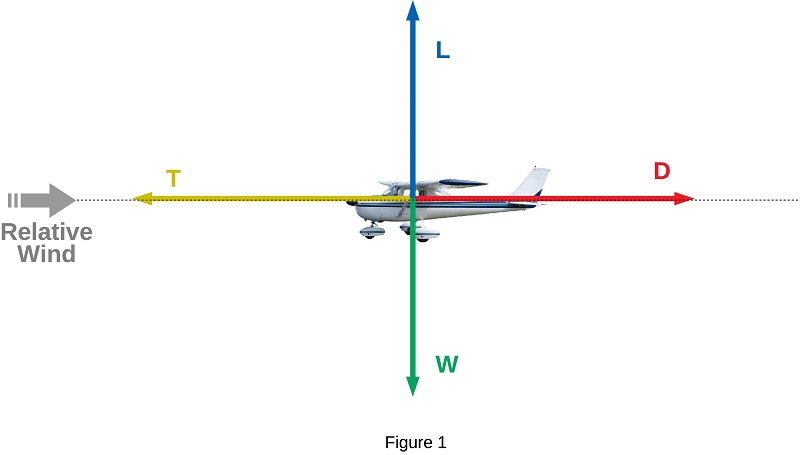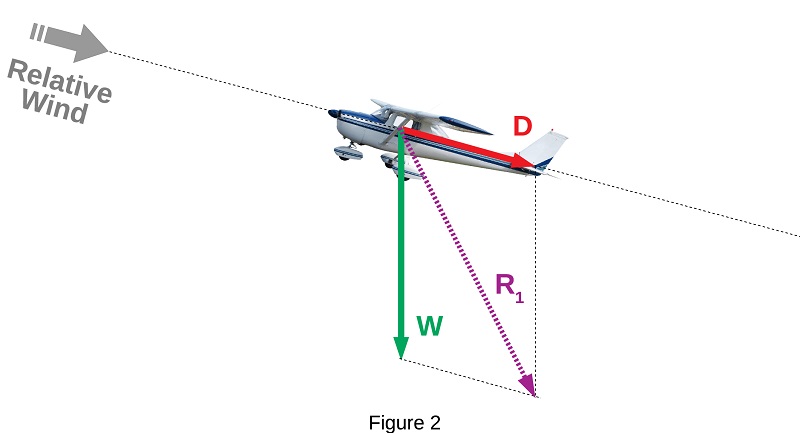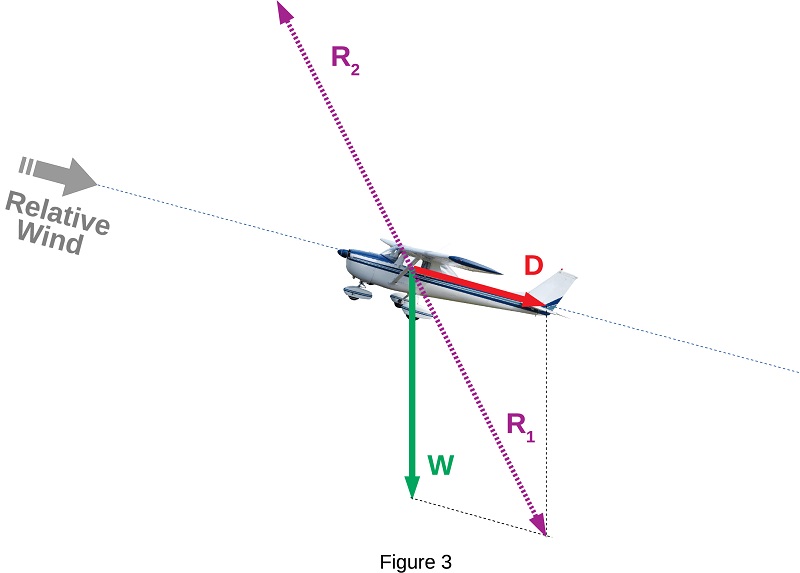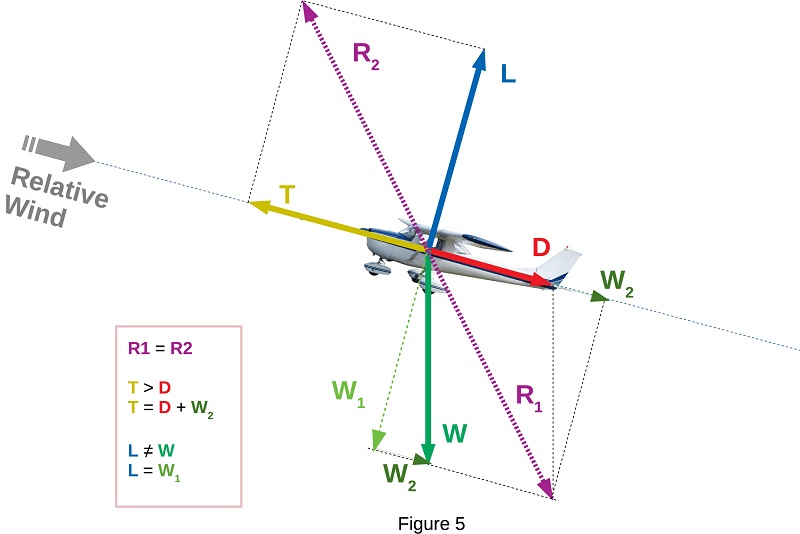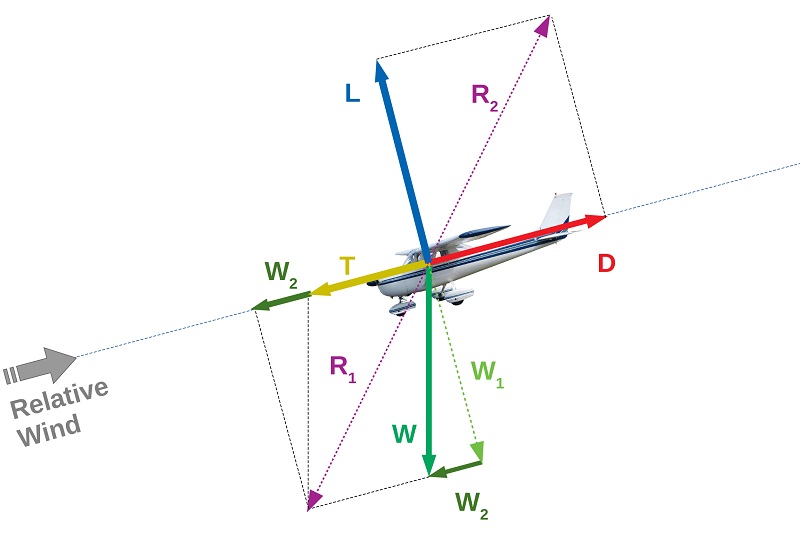Gleim Aviation customers submit thousands of great questions through our online courses every year. This article highlights a common area of interest (or confusion) for many pilots: whether or not an airplane is in equilibrium during a constant-airspeed climb and descent.
Newton’s First Law of Motion states that every object in a state of uniform motion (such as constant-airspeed) will remain in that state of motion unless an external force acts on it. Before we can fully understand the dynamics of constant-airspeed climbs and descents, we should first be clear on the forces acting on our airplane in straight-and-level flight. In figure 1 below, we have an airplane flying straight and level at a constant airspeed, with vector forces depicted.
For an airplane to maintain steady, unaccelerated flight, all opposing forces must be balanced. The lift (L) generated by the wings must be equal to the weight (W) of the airplane. Additionally, the rearward force, or drag (D), generated by the structure of the airplane must be offset by an equivalent magnitude of forward thrust (T).
On a technical note, there is a downward component of the force generated by the horizontal stabilizer (lift acting towards the ground) and a small upward component of the force produced by the propeller at positive angles of attack. For the sake of simplicity, these forces are depicted as one net force of lift over the wings, acting upward and perpendicular to the airplane’s flight path.
When the sum of forces in one direction balance the sum of forces in the opposite direction, an airplane is in equilibrium. This is apparent in straight and level flight. Consider this, can an airplane be in equilibrium when it is transitioning into a climb or descent?
No, it cannot – at least, not while transitioning. For an airplane to transition from straight-and-level flight into a climb, thrust has to be increased. When this happens, the force of thrust becomes greater (for a time) than the rearward force of drag. Because these two forces are no longer equal, the airplane begins to accelerate in the direction of the prevailing force, thrust. Whenever the forces acting on an object are unbalanced, the object will accelerate in the direction of greatest force.
As an airplane in straight-and-level flight increases its thrust, air moves over the wings at a greater velocity and generates a greater force of lift, causing the upward force of lift to become greater than the downward force of weight. Using what we have just learned, we know the airplane will begin to accelerate both forward (due to greater thrust) and upward (due to greater lift) and will start to climb.
Once the airplane is climbing, the rate at which airspeed increases (the acceleration rate) will decrease until it reaches a point where the airspeed becomes stable (i.e., the airplane is no longer accelerating), assuming no other inputs are changed. This is where the constant-airspeed climb begins; the point at which the airplane has again arrived at a state of equilibrium.
You will practice this maneuver during your training. For example, your instructor will ask you to maintain a 500 FPM rate of climb at 80 knots. Initially the aircraft’s acceleration will decrease, so you’ll adjust the pitch, power, and trim until the airplane maintains this specification in a relatively hands-off configuration. But why does the aircraft’s acceleration decrease? To explain, let’s break down the concept in parts.
Figure 2 above depicts an airplane in a constant-airspeed climb with the forces of drag and weight depicted. The forces of drag and weight can be summed into a resultant force (R1) as shown. Because an airplane in equilibrium needs to have the sum of forces balanced in all directions; this means that R1 requires an opposing force with equal magnitude, which is illustrated in Figure 3 below.
The opposing force (R2) is comprised of thrust (T) and lift (L), as shown below. The resultant sum of drag and weight (R1) is equal to the resultant sum of lift and thrust (R2), putting this airplane in a constant-airspeed climb and in equilibrium.
Notice that thrust and drag are not equal, and neither are lift and weight. This is because weight is a force that always acts toward the center of the Earth. In a climb, weight is no longer acting perpendicular to the flight path; it is at an angle. Therefore, thrust needs to overcome not only the force of drag, but also the component of weight acting parallel to the flight path, depicted as W2 in Figure 5 below.
While a plane is transitioning to a constant-airspeed climb after thrust is added during straight-and-level flight, pitch increases, and conversely, weight pulls the plane rearward until all opposing forces are again in equilibrium. Because these compounding forces attempt to pull the plane rearward in a climb, more thrust is necessary for the plane to maintain its upward flight path.
The airplane in Figure 5 is in a constant-airspeed climb (and in equilibrium) because:
- The magnitude of thrust is equal to drag plus the rearward component of weight (W2), and
- Lift is equal to the downward component of weight (W1).
The image is almost mirrored in a descent. In a descent, thrust acts in conjunction with (rather than against) the component of weight that is parallel to the flight path. These compounding forces exceed drag as shown in figure 6, so to establish equilibrium, thrust must be reduced.
By drawing out the forces that act on an airplane in a constant-airspeed climb or descent, the concept of equilibrium becomes more apparent. Understanding that opposing forces in all directions are actually balanced allows us to grasp this concept coherently and better appreciate Newton’s First Law of Motion. The concept of equilibrium is an important concept for all pilots understand. Rarely do courses go in depth to explain the fundamental principals that comprise the forces acting around us. Instead we often learn the basics of aerodynamics, then try to comprehend pitch-power performance so we can fly according to some standard to simply pass a practical test. We believe you should know more.
If a good pilot is always learning, the best learn from Gleim! If you would like to learn more about constant-airspeed climbs and descents, the instructors at Gleim recommend that you pick up a copy of the Gleim Flight Maneuvers and Practical Test Prep book relevant to your pilot certificate, or rating. These books explain every line from the Airman Certification Standards with precise detail in plain (plane?) English. You’ll know exactly what you need to know, consider, and do with simple step-by-step instructions, illustrations, and common errors relevant to each area of operation and task element for your practical test.
Written by Ryan Jeff, Gleim Aviation Research Assistant


